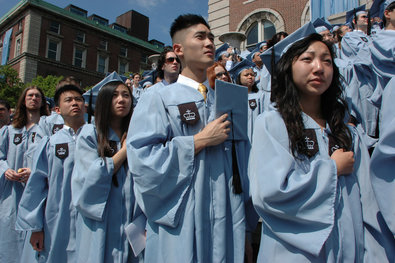
The Effects of Seeing Asian-Americans as a ‘Model Minority’
Asian-Americans are often categorized as a single group, comprising about 5.4 percent of the U.S. population. But despite economic disparities between nationalities, it is the highest paid racial group, and its members are more likely to be seen as advantaged, than disadvantaged. But is it fair to stereotype Asian-Americans as a “model minority,” free of the burdens of discrimination? Or do they also face obstacles as other nonwhite groups do?
* effect = 영향, 결과, 효과/ categorize = 분류하다, ~을 범주에 넣다/ comprise = 구성하다, 차지하다/ despite = ~에도 불구하고/ economic disparity = 경제적 격차(불평등)/ stereotype = 정형화하다/ (be) free of ~ = ~이 면제된, ~을 떠나서/ obstacle = 장애(물)
 아시아계 미국인들을 차별의 부담이 없는 모델 소수민족으로 정형화하는 것이 옳은가?
아시아계 미국인들을 차별의 부담이 없는 모델 소수민족으로 정형화하는 것이 옳은가?
아니면 그들도 다른 백인이 아닌 집단처럼 난관을 직면하나요?
1. A Seeming Compliment That Does Great Harm
It ignores the struggles of many Asian nationalities, divides the races and can put disabling pressure on young people.
2. Reason for Pride After Overcoming Racism
After years of vilification, a culture of achievement thrived, enabled by changes in America’s economy, buoyed by ethnic support.
3. It Isn’t Easy Being a Model Minority
If you have great grades, but not supersonic, epic, straight A-pluses in all AP classes, you are just considered a loser — by your family.
4. A Bamboo Ceiling Exists
The stereotype of quiet, talented professionals breeds a widespread assumption that they are ill-suited to be business leaders.
5. National Origin Data Would be Helpful
For Asian-Americans, differences in nationality can be quite stark on aspects ranging from education and income, to health outcomes and language proficiency.
Sample Essay
“Model Minority” Seems Like a Compliment, but It Does Great Harm
For labels that sound so promising in tone, the “model minority” and “Asian advantage” stereotypes do nothing but render discrimination against Asian-Americans invisible.
Arguments of Asian cultural superiority often try to validate the model minority label: The success of Asian-Americans in the United States is “a tribute to hard work, strong families and passion for education.” Positive stereotypes about Asian-Americans are frequently seen as more beneficial than detrimental to the student psyche, in spite of research that these stereotypes harm Asian-American students' mental health and well-being.
The most poignant consequence of the model minority label is its failure to acknowledge socioeconomic and education disparities among the diverse range of communities categorized as Asian-American. Not all ethnic communities under the Asian-American umbrella are advantaged. Southeast Asian-Americans drop out of high school at an alarming rate; nearly 40 percent of Hmong-Americans, 38 percent of Laotian-Americans, and 35 percent of Cambodian-Americans do not finish high school. These Asian-American subgroups, along with Vietnamese-Americans, earn below the national average. Sweeping generalizations of Asian-Americans as the “privileged” and “successful” minority cannot replace unnerving disaggregated data that bring truth to the inequalities that many Asian-Americans face daily.
Often in history, Asian-Americans cultural values have been lauded as a way to enable interracial tension. The term “model minority” seems to have been first coined during the Civil Rights Movement in a 1966 New York Times article entitled “Success Story, Japanese American Style”. The positive stereotype caught on, influencing articles such as U.S. News and World Report’s “Success Story of One Minority Group in U.S.” in 1968, Newsweek’s “Success Story: Outwhiting the Whites” in 1971, and the Time magazine’s 1987 cover headlining “Those Asian-American Whiz Kids”. These sensationalized articles similarly argue: if Asian-Americans can “work hard” and “never complain”, why aren’t other racial groups following suit? Cultural normalization and perpetuation of the model minority label operates as a racial wedge that divides Asian-Americans from communities of color while maintaining white dominance in leadership (i.e. the “bamboo ceiling”) and politics.
Recent affirmative action lawsuits by initiatives such as Project on Fair Representation continue to employ Asian-Americans as racial mascots for the anti-affirmative action debate. These lawsuits outline unfairness in the college admissions process for Asian-American students often in comparison to the academic and extracurricular profiles of their black and Latino counterparts. College admissions should not be framed as a zero-sum game among racial minorities if policies such as legacy preferences that overwhelmingly benefit white students remain unchallenged.
The model minority is yet another myth of meritocracy that reinforces racial hierarchy and shrouds discrimination. It’s time to acknowledge the truth: the model minority does not exist.





![]() 아시아계 미국인들을 차별의 부담이 없는 모델 소수민족으로 정형화하는 것이 옳은가?
아시아계 미국인들을 차별의 부담이 없는 모델 소수민족으로 정형화하는 것이 옳은가? 






